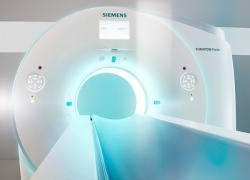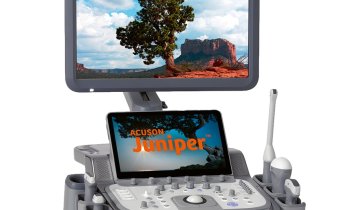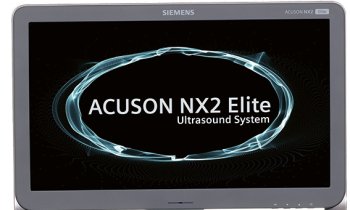Somatom Force opens CT to highly sensitive patients
Somatom Force – the new computer tomograph (CT) from Siemens – recently had its first public presentation worldwide at the University Medical Centre Mannheim, Germany.

Source: Siemens
Somatom Force – the new computer tomograph (CT) from Siemens – had its first public presentation worldwide at the University Medical Centre Mannheim, Germany in mid-November. In its first few weeks of clinical use at Mannheim’s Institute for Clinical Radiology and Nuclear Medicine, the third generation of Dual Source computed tomography (CT scanners each with two radiation tubes and detectors) enabled considerably quicker and more precise diagnoses at reduced doses. This high-end CT offers individualized diagnoses now especially also for challenging patients, e.g. for very young patients or people suffering from renal insufficiency, the seriously ill, and obese patients. “In a general population with a very complex age and disease structure, this new CT scanner can solve the problems presented by every radiological situation for virtually every patient,” says Institute Director Professor Stefan Schönberg.
Patients suffering from renal insufficiency will benefit from the significant reduction in contrast medium. Early detection examinations and functional 4D imaging can be conducted using up to 50 percent lower radiation dose. This means that this procedure can now be used on a routine basis and physicians can make quicker and more well-founded decisions as to which tumor therapy to use for the individual in question.
Less contrast medium reduces burden on the kidneys
“Somatom Force negates many aspects of computed tomography that up to now have limited its application. For example, the administration of contrast medium that proves problematic for many patients can be greatly lowered,” says Walter Märzendorfer, CEO of Computed Tomography and Radiation Oncology at Siemens Healthcare. Up to 20 percent of patients suffer from renal insufficiency. Contrast medium containing iodine can place extra burden on the kidneys of older patients and those with chronic illnesses in particular. Initial examinations in Mannheim show that the average quantity of contrast medium administered in thoracic examinations can be lowered from between 90 and 110 milliliters (ml) to between 25 and 35 ml. This is made possible by the two Vectron X-ray tubes in Somatom Force, which enable routine examinations at particularly low tube voltages of 70 to 100 kilovolts. As the contrast-to-noise ratio rises, the amount of contrast medium can be lowered accordingly.
Precise diagnoses for individual treatment
Somatom Force can also deliver considerable added value in treatment control. 4D imaging, which shows the function of organs and vessels next to their morphology, is particularly important here because it allows additional information to be gleaned about primary tumors and metastases. A disadvantage of this dynamic perfusion is that – up to now – high dose values of more than 50 millisievert (mSv) in certain cases are required e.g. for liver imaging. This dose can now be more than halved with Somatom Force. In one of the Mannheim cases, just 14.7 mSv was required. Such values enable the procedure to be used routinely, thus enabling quicker and more well-founded decisions to be made about which treatment is most suitable for an individual patient.
In the case of novel but also very expensive anti-angiogenesis therapies, which inhibit the formation of blood vessels in the tumor through the administration of medication, Somatom Force can be used to determine precisely at a much earlier stage whether the treatment is working. If it is not, physicians can move to a more effective treatment more rapidly. This improves the cancer patient’s chances of receiving effective treatment as quickly as possible – and thus of surviving. It can also help to ensure that medication costing several thousand euros per month is deployed more efficiently and so to reduce the overall cost of the treatment. Usually, long-term CT monitoring is used to identify the correct time to potentially switch treatments. The significantly reduced cumulated radiation dose with Somatom Force is of enormous advantage here. “This computer tomograph means that medical imaging is no longer restricted to traditional diagnostics,” explains Professor Schönberg. “As radiologists, we can now work toward the ultimate goal of all medical intervention: The patient’s recovery.”
Early cancer detection at up to 50 percent lower dose
The NLST lung cancer screening study conducted in the U.S. has prompted a realignment of priorities in cancer prevention: The study showed that mortality rates can be reduced by 20 percent if early lung cancer detection is performed with lowdose CT rather than conventional chest X-rays. Somatom Force is particularly suitable for such early detection examinations due to its previously unattained low dose values. Up to 50 percent lower than that of previous high-end CTs, this radiation dose can be attributed to the “Turbo Flash Mode” of Somatom Force and the use of two special spectral filters – Selective Photon Shields – which optimize the X-ray spectrum and thus significantly improve the air/soft-tissue contrast. Examinations performed at the University Medical Centre Mannheim show that dose values of 0.1 mSv for a lung scan can be achieved with Somatom Force – even in routine clinical situations. “With Somatom Force, there are almost no more contraindications for computed tomography,” says PD Dr. Thomas Henzler, Head of Cardio-Thoracic Imaging at the University Medical Centre Mannheim.
Thorax diagnostics without breath-hold
Another advantage in pulmonary diagnostics is the enlarged field of view (50 centimeters) of the “Turbo Flash Mode” on Somatom Force, which covers the entire organ. This extremely quick scan mode with an acquisition rate of almost 400 millimeters per second allows the entire thorax to be depicted in around one second. If a larger area of the body is to be scanned, thanks to the fastest acquisition rate on the market (737 mm/s) entire thoracic-abdominal examinations can even be performed in just one second. This means that patients may not need to hold their breath. With Somatom Force, even high heart rates do not lead to disruptive motion artifacts in clinical images, a fact indicated by images taken of a female patient with 90 heartbeats per minute and no medicinal measures to lower her heart rate.
14.11.2013










